Don’t try this at home. . . or ANYWHERE for that matter!
July 15, 2024 by Laura Heilenman · Leave a Comment
 We have all heard various versions of, “Kids, Don’t try this at home!”, including in 1966 when Batman and Robin (Adam West and Burt Ward) told us, “Remember kids, Batman can’t fly.”
We have all heard various versions of, “Kids, Don’t try this at home!”, including in 1966 when Batman and Robin (Adam West and Burt Ward) told us, “Remember kids, Batman can’t fly.”
Perhaps Ben Franklin should have penned “Don’t try this at home. . . or anywhere” shortly after he successfully completed his famous lightning/kite experiment. If he had thought this through, we may never have had his follow-up letter describing copycat deaths printed in…
THE AMERICAN MUSEUM OR UNIVERSAL MAGAZINE, September 1790.
Thankfully he survived his own efforts in 1752.
So, just in case you missed the memo, remember kids, Batman can’t fly… or catch lightning, and neither can you!
The Founding Documents – the Bill of Rights edition…
July 12, 2024 by Laura Heilenman · Leave a Comment
I recently read about a “man on the street survey” where people were asked to choose one of the rights enumerated in the Bill of Rights from a list of 4 options. The options were: The right to vote, the right to healthcare, the right to a public education and the right to trial by a jury of your peers. Sadly, most of those interviewed did not pick the correct one. Even worse, most picked either the right to healthcare or the right to a public education. I quickly sent a group text to my adult children and asked them the same question and then awaited their responses with a bit of trepidation. Thankfully, my concern was unfounded.
One of the reasons we at RareNewspapers.com love what we do is that we feel as if we are helping to keep the heart of our country alive by protecting authentic papers containing real-time (contemporary) reports regarding our founding documents such as the Bill of Rights. The portion shown below was printed in THE PENNSYLVANIA PACKET & DAILY ADVERTISER, Philadelphia (PA), October 6, 1789. Newspapers like these need to be cherished and their message intentionally disseminated to all generations so future surveys are a bit more encouraging. Thanks in advance.
This Month in History – July…
July 8, 2024 by GuyHeilenman · Leave a Comment
July was a busy month from a (an) historic perspective. While it has always been a “time for war”, some of the most amazing discoveries, accomplishments, and human advancements have also made their way onto the historic July Calander. While the list is almost endless, three-handfuls include:
- A French soldier discovers the Rosetta Stone (July 19, 1799)
- First photographs were used in a newspaper (July 1, 1848)
- U.S. Congress authorizes the Medal of Honor (July 12, 1862)
- P.T. Barnum’s Museum burns down (July 13, 1865)
- Philadelphia Zoo opens, the first zoo in the U.S. (July 1, 1874)
- President Garfield is shot (July 2, 1881)
- Louis Pasteur successfully gives first anti-rabies vaccination to nine-year-old (July 6, 1885)
- The 16th Amendment, the power to tax income, is passed by Congress (July 12, 1909)
- Albert Einstein introduces his Theory of Relativity (July 1, 1905)
- “Lady Astor’s Bill” passes lowering UK drinking age to 18 (July 13, 1923)
- The bikini is showcased for the first time (July 5, 1946)
- Walt Disney’s Disneyland opens in Anaheim, CA (July 17, 1955)
- The first moon walk takes place (July 20, 1969)
- Hank Aaron hits his 755th and last home run (July 20, 1976)
- First ‘Test Tube Baby’ is born (July 25, 1978)
For those who have interest in exploring the available newspapers at RareNewspapers.com which may contain reports on some of the above, along with a host of other newsworthy articles, a link to the chronological list is shown below. We hope you enjoy your trek.
NEWSPAPERS PUBLISHED IN JULY
The revered September 15, 1790 issue of the Gazette of the United States. The back story…
July 1, 2024 by TimHughes · Leave a Comment
We are very proud to offer the most significant American newspaper with Jewish content, in which Washington assured the congregation of the Touro Synagogue in Newport, Rhode Island, that the United States “…gives to bigotry no sanction, to persecution no assistance…”, perhaps the more famous utterance by a President in the establishment of religious freedom.
The newspaper is the “Gazette Of The United States” dated September 15, 1790, published in New York at the time. To fully appreciate its significance, we offer the following “back story” to this issue containing both Seixas’ letter of welcome to Washington,
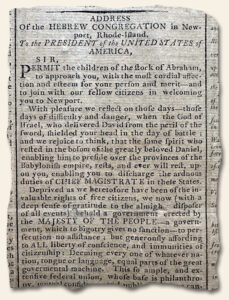
and Washington’s response to the congregation of the Touro Synagogue.
Upon his election as President, many churches, congregations, and religious societies wrote to George Washington to congratulate him on his new office, and he replied to each of them with personalized messages of thanks for their well-wishes. In his reply to the Hebrew Congregation of Newport, Washington applauded the people of the United States for rejecting the European practice of religious “toleration,” embracing instead the “large and liberal policy” that religious liberty is a natural right — and not a gift of government — which all citizens are equally free to exercise.
In 1790, George Washington visited Rhode Island to acknowledge the state’s recent ratification of the Constitution and to promote passage of the Bill of Rights, the first ten amendments to the Constitution. As was the custom, when Washington visited Newport, he was met by a delegation of citizens, who read messages of welcome. One of those who welcomed Washington was Moses Seixas, the warden of the Touro Synagogue in Newport. Touro is the oldest synagogue building in America and the only one existing from the colonial era. In his welcome, Seixas gave thanks to “the Ancient of Days, the great preserver of men” that the Jews, previously “deprived … of the invaluable rights of free Citizens” on account of their religion, now lived under a government “which to bigotry gives no sanction, to persecution no assistance.”
Washington was moved by Seixas’ letter. The president’s response differentiated between religious toleration and religious liberty, as it specifically applied to American Jews. Washington wrote that Americans “have a right to applaud themselves for having given to mankind examples of an enlarged and liberal policy – a policy worthy of imitation . . . It is now no more that toleration is spoken of as if it were the indulgence of one class of people that another enjoyed the exercise of their inherent natural rights.”
Washington’s reply set a significant precedent that separated a more passive practice of tolerance, from the more potent one of liberty. Even the most liberal European states such as the Netherlands had policies that merely tolerated non-Protestants. In alluding to the Bible’s Old Testament, Washington unequivocally called for religious equality for Jews stating that “the Children of the Stock of Abraham . . . shall sit in safety under his own vine and fig tree.”
Notably, Washington imitated Seixas’s phrasing in his reply in writing that the United States “gives to bigotry no sanction, to persecution no assistance” requiring only that they who live under its protection should demean themselves as good citizens, in giving it on all occasions their effectual support.” The president’s reply made loyalty to country, as opposed to Protestant allegiance, the prerequisite for religious equality.
This letter was written during Washington’s first term as President and is Washington’s clearest statement of religious tolerance. It is considered a steppingstone for the First Amendment that would come the following year in 1791 and is considered a foundational document establishing Washington’s belief in the separation of church and state.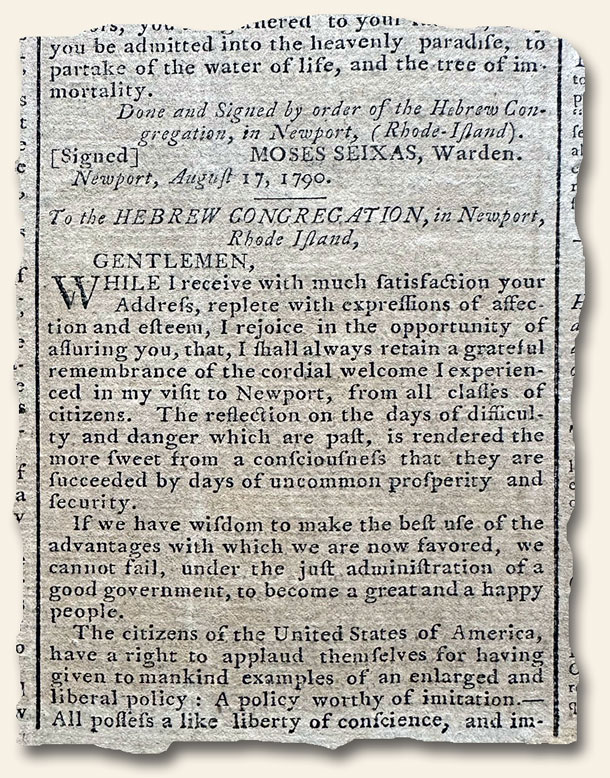
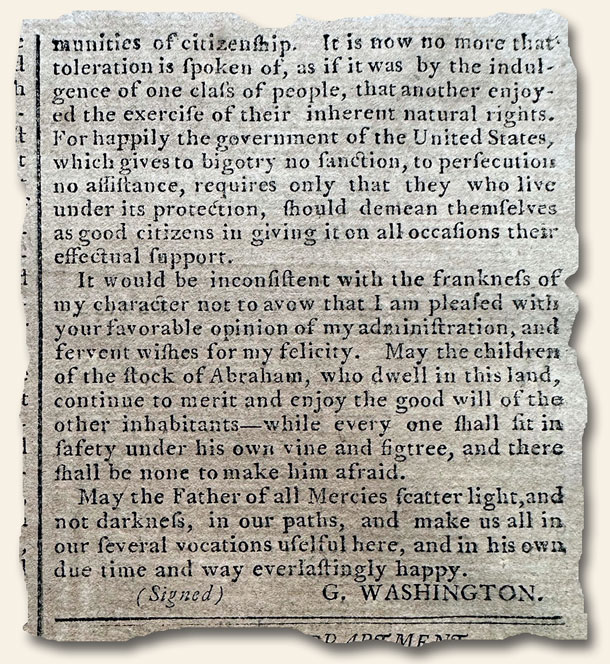
Announcing: Catalog #344 for July, 2024 – Rare & Early Newspapers…
June 28, 2024 by GuyHeilenman · Leave a Comment
|
|
[The links above will redirect to the latest catalog in approx. 30 days
upon which time it will update to the most recent catalog.]
Be sure you are buying what you think you are buying…
June 10, 2024 by TimHughes · Leave a Comment
History can throw collectors a curve ball now and then. If something read in an early newspaper doesn’t seem quite right, take a few moments to research. With the plethora of information on the internet today, it need not be difficult nor time-consuming.
When writing up a 1792 newspaper reporting the installation of the cornerstone of the President’s house, at first blush it seems to agree with history. The cornerstone of what is now known as the White House was, indeed, laid in 1792. But it reports it happened in Philadelphia. Okay, the nation’s capital moved from New York to its temporary location in Phila. for ten years while the District of Columbia was being built out, so again the report seemed logical. However, more research uncovered what was being reported. The newspaper is the Columbian Centinel from Boston, dated May 26, 1792. Page 3 has a somewhat inconspicuous report reading: “The following inscription is cut on the cornerstone lately laid as the foundation of the house designed for the future residence of the President of the United States, viz ‘This Corner Stone of the House to Accommodate the President of the United States, was laid May 10, 1792; when Pennsylvania was out of debt; Thomas Mifflin then Governour of the State’.”
The newspaper is the Columbian Centinel from Boston, dated May 26, 1792. Page 3 has a somewhat inconspicuous report reading: “The following inscription is cut on the cornerstone lately laid as the foundation of the house designed for the future residence of the President of the United States, viz ‘This Corner Stone of the House to Accommodate the President of the United States, was laid May 10, 1792; when Pennsylvania was out of debt; Thomas Mifflin then Governour of the State’.”
Here is the background of the report:
As mentioned, the U.S. capital did move to Philadelphia. The President’s House was a mansion built from 1792 to 1797 by the state of Pennsylvania, located on Ninth St. between Market and Chestnut Streets, in Philadelphia. This was done to persuade the federal government to permanently stay in the city, yet this house intended for the president of the United States never housed any president.
On July 16, 1790, Congress passed the Residence Act which designated Philadelphia the temporary capital for a 10-year period while the permanent capital at Washington, D.C., was constructed. The recently built Congress Hall was used from December 6, 1790, to May 14, 1800. The president of the United States, first George Washington and then John Adams, resided at the house leased from financier Robert Morris, also known as the President’s House, on Market Street, between Fifth and Sixth Streets.
In September 1791, the Pennsylvania state government enacted the “Federal Building Bill” to pay for the renovations needed for the federal government office space and for the construction of a new executive mansion. Twelve lots were purchased on the west side of Ninth Street, between Market Street, then named High Street, and Chestnut Street.
This is the building with the cornerstone mentioned in the newspaper report, laid on May 10, 1792 (the cornerstone of the White House in Wash. D.C. was laid five months later). On March 3, 1797, Penna. Governor Mifflin offered the nearly completed mansion to John Adams on the eve of his inauguration. But Adams rejected the offer on constitutional grounds stating “as I entertain great doubts whether, by a candid construction of the Constitution of the United States, I am at liberty to accept it without the intention and authority of Congress”.
Thus neither Washington, no longer president when the mansion was ready, nor Adams, would reside in the President’s House in Philadelphia.
In 1800, the University of Pennsylvania purchased the property at public auction for use as a new, expanded campus. The university demolished the building in 1829 and replaced it with two new buildings.
So goes the interesting history of the “White House” that never was. Yet the report is an interesting piece of history nonetheless.
This Month in History – June…
June 3, 2024 by GuyHeilenman · Leave a Comment
Continuing with our series of “This Month in History”, we thought we’d jump right in and provide the link to the available issues which were published during the month of June. This time around we’ve arranged them in chronological order to provide a newspaper version of a walk forward through time – from 1666 to 2022. Enjoy.
Announcing: Catalog #343 for June, 2024 – Rare & Early Newspapers…
May 31, 2024 by GuyHeilenman · Leave a Comment
|
|
[The links above will redirect to the latest catalog in approx. 30 days
upon which time it will update to the most recent catalog.]
Another Golden Nugget found within an Old Newspaper… Edmund Halley
May 24, 2024 by GuyHeilenman · Leave a Comment
A collector (L.G., from Vermont) recently contacted us to mention he had found a “Golden Nugget” within one of our listings. Finding hidden gems while perusing a newspaper is not too uncommon (it’s one of the pleasures of the collectible), however, doing so while viewing merely select images on our website is another thing altogether. Making this “find” even more impressive is that it was barely visible at the bottom of a photo showing something else. SO, what was “the find”? An advertisement for the notable “Planisphaerium Coeleste (double hemisphere celestial chart)” which had been “reviewed and corrected” by the 23-year-old astronomer, Edmund Halley. He would later become famous for discovering that a series of comet sightings which reached as far back as 240 BC were actually of the same comet – now called Halley’s Comet (1P/Halley). From a collector’s standpoint, it’s nice to see his name in print long before his famous “find”.
For the record, the mention was found in The London Gazette for April 10, 1679 – a listing which has now been updated to reflect the new content. The original photo observed by L.G. can still be found through the provided link.
Please know we are always pleased when collectors let us know of such discoveries – even if the find means we missed something which would have made the newspaper significantly more valuable.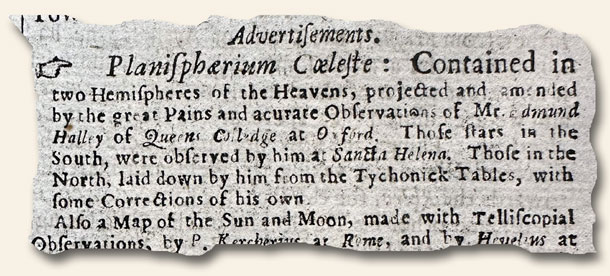
The Month of May thru time – as reported in newspapers of the day…
May 10, 2024 by GuyHeilenman · Leave a Comment
 When considering the month of May what historical events come to mind? I’m sure if we each came up with a list of ten, while there may be some overlap, our lists would be quite diverse. A quick internet search turned up an exhaustive list which included the following:
When considering the month of May what historical events come to mind? I’m sure if we each came up with a list of ten, while there may be some overlap, our lists would be quite diverse. A quick internet search turned up an exhaustive list which included the following:
- Great Britain was formed from a union between England and Scotland
- U.S. Special Operations Forces killed Osama bin Laden
- Decoration Day (now Memorial Day) was first observed in the U.S. (1865)
- Communism founder Karl Marx (1818-1883) was born in Treves, Germany
- The German airship Hindenburg burst into flames
- The British passenger ship Lusitania was torpedoed by a German submarine
- Nelson Mandela was inaugurated as president of South Africa
- The first permanent English settlement in America was established at Jamestown, Virginia
- Napoleon Bonaparte became Emperor of France
- Mount St. Helens volcano erupted in southwestern Washington State
Collectors of rare and early newspapers know that coverage of such events can nearly always be found in old newspapers; however, one of the added pleasures is discovering reports of previously unknown or long-forgotten events which inspire a deeper look – aiding the lifelong learning process which helps to keep us mentally engaged as we progress through life.
The link below will take you to a reverse-chronological list (1600’s-20th century) of our currently available newspapers from the month of March. There’s no need to buy anything. Simply enjoy your march backwards through time.







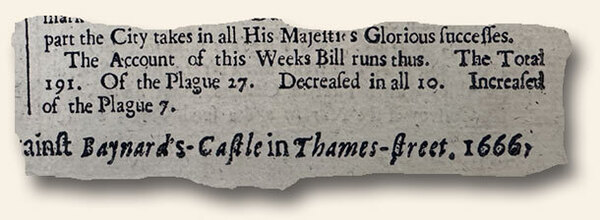
 The June catalog (#343) is now available. Shown below are links to various segments of the catalog, our currently discounted
The June catalog (#343) is now available. Shown below are links to various segments of the catalog, our currently discounted 